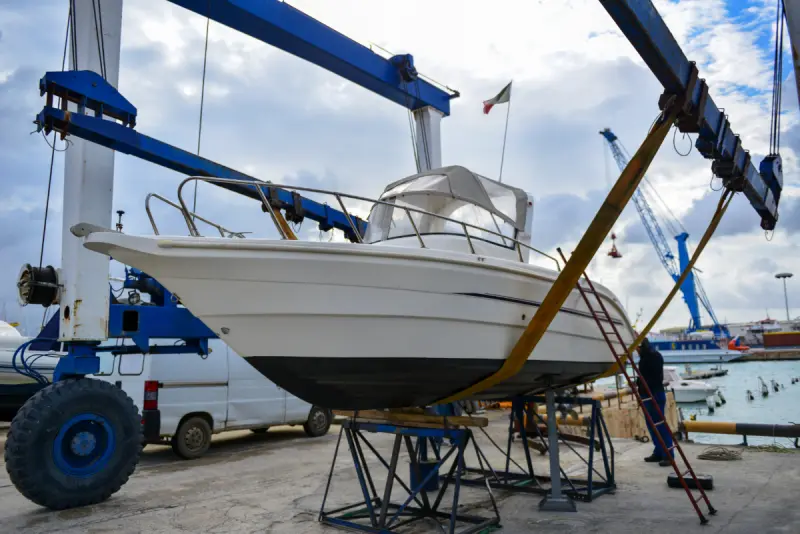Find out how to maintain a boat's hull. This article discusses hull maintenance tips and advice for cleaning the hull. Find out more about boat hull maintenance.
Fibreglass Hulls
Fibreglass is one of the best materials to build boat hulls from for two reasons. The first is that fibreglass is a sturdy material that resists the wear and tear of being in the water, and the second is that fibreglass comes with an additional gel coating, protecting your boat from scrapes and bumps.
And these scrapes and bumps are highly likely when boating since you'll be coming into close contact with docks, pilings and other boats when out on the water. However, while fibreglass hulls are famously robust, there will come a time when they will require maintenance to keep them in good condition.
One of the biggest threats to the integrity of your fibreglass hull is harmful UV rays from the sun. If you can't store your boat indoors away from these UV rays and have to leave it moored in the water while you aren't using it, harsh sunlight will likely damage your hull. Ultraviolet rays can bake the gel coating and, subsequently, the fibreglass hull beneath.
Therefore, the more time your boat spends in direct sunlight, the more rays the hull will absorb, leading to ageing and cracking in the gel coating. Aside from structural damage, leaving your boat moored in the water for months can also lead to a build-up of sediment, barnacles, algae or minerals on your hull, which can ruin its aesthetics.
Boat Hull Cleaning
Many boat owners may be daunted by the prospect of cleaning a fibreglass hull and maintaining a clean boat. However, looking after and cleaning your fibreglass hull is a relatively straightforward part of boat ownership.
While professional maintenance work and boat cleaning services can truly restore your boat's hull, there's no reason why you can't put in a little elbow grease and carry out some maintenance tasks yourself. Like any other vehicle, regular boat maintenance and having a basic boat maintenance checklist is the best way to take care of your boat's hull.
Part of this must include washing down the hull with fresh water after you've taken your boat out sailing. Cleaning most boats really is that simple.
Freshwater is the best way to remove and keep salt, sediment and other water debris from accumulating on your fibreglass hull. Using marine soap or dedicated hull cleaning products is also a great idea for more thorough cleaning.

However, not everyone has the time to spend days thoroughly cleaning their boats. Therefore, a good overall wash with clean, fresh water is usually the best and least time-consuming method of keeping your hull in good shape.
When you have the time to give your hull a full clean, the main area you want to concentrate on is the gel coating.
Additionally, if you want to clean your hull properly, you'll need the right equipment to avoid damaging your hull during the process. For the gel coating, microfiber cloths or soft-bristle brushes are the best tools for the job. Regarding cleaning products, if you're only dealing with light waterline stains, using a gentle stain removal solution is the best way to start.
Using anything too harsh immediately may harm your fibreglass hull, potentially leading to cracks. Light application, as per the product instructions, is the safest way to proceed with stain removers.
Once you've cleaned your hull, remember to wash any hull cleaning chemicals or marine soap from the surface with fresh water.
It would also be best to allow your hull to dry completely before moving on to the polishing stage. Hull wax is the best way to polish a fibreglass hull, but, again, boat owners should ensure the hull is completely dry before applying it.
Boat Cleaning Tips
While keeping a boat clean may sound time-consuming, it's far easier than most people think. The main thing to remember is that regularly scheduled maintenance is the best way to reduce the amount of effort you need to put in.
It will also save you money in the long run since a clean hull means a more streamlined vessel, meaning less fuel is needed to propel it.
Additionally, putting in some hard work straight away will make your life easier down the line and reduce maintenance costs. One area where this is most true is with your boat's topsides. Here the surface should be mirror-smooth to ensure water and debris are repelled.
If you allow your hull to become dirty and dull, more and more dirt will build up on your boat's sides. These particles will form a rough surface, reducing the streamlined nature of your boat, ultimately slowing it down and requiring you to clean it more often.
Here are more of our boat maintenance tips for keeping your boat clean:
Depending on how dirty your deck is, you can either use a deck brush or wire brush with stiff bristles or a pressure washer to clean your fibreglass boat.
Alternatively, if you have a teak deck made of natural timber or particularly smooth areas, it'll need a more gentle clean. This is because exposed areas between the grain can be quite soft.
Therefore, to maintain the beautiful patina on your teak deck, you'll want to ensure it gets plenty of sunlight and wash it with plenty of saltwater.
Canvases, whether sail covers, cockpit covers, sprayhoods, biminis or dodgers, can quickly become dirty if left wet and unwashed for extended periods. This is because algae and mould are attracted to the dirt that gets stuck in wet canvas, and as these build up over time, they can gradually ruin the look of your canvases.
Therefore, this is an area you need to pay close attention to. Again, the best remedy here is fresh water. Salt and dirt are two of the main reasons your canvases can become dirty, so washing your canvas with fresh water will keep the mould at bay.
If you find mould on your canvas, brush it gently with mould cleaner before rinsing the fabric again. You might also consider treating your canvas with water-resistant products to add further protection and keep the problem from recurring.
Seawater can cause your ropes to become stiff and unusable, but washing fresh water on a regular basis comes to the rescue once again. If your ropes are particularly dirty, washing them in a tub filled with warm, soapy water should do the trick.
You may need to scrub your ropes with a soft sponge for the worst-affected areas. Modern boats often come with modern ropes, which won't fare well in a washing machine, so a gentle sponge wash is the best method.
One of the best ways to keep the interior of your boat clean is to ensure it remains dry when at its mooring. You can achieve this by using a dehumidifier if you're close to shore facilities and can access electrical power sources.
Suppose you don't have access to facilities like this. In that case, you can do your best to ensure your boat's interior and any safety gear or electrical components housed there remains well-ventilated while not in use. Swinging moorings typically provide the best ventilation, even in tidal waters.
This is because your boat will naturally be pointing head-to-wind enough times throughout the day to provide good airflow through the interior. It'll be trickier to achieve this at a fore-and-aft mooring or pontoon mooring, but you can find solar-powered devices to draw air through the entire vessel as a solution for a well-maintained boat.
Given how devastating moisture can be for a boat, from its canvases to its interiors, it is vital to ensure you clean up any spills or moisture on your soft furnishings. This is because of mould or fungi growth, which can spread to other areas of your vessel once established.
Detergent and vinegar solutions are usually best for soft furnishings and food spills. However, use it on a test area first to see if it'll ruin the fabric of your cushions before applying it more widely.
Keeping the remainder of your boat clean will be impossible if you don't take proper care of your bilges. Any engine leaks should be contained within the engine compartment to avoid spreading oil, fuel or dust to other areas.
This will also make it easier to trace any leaks in the future, ultimately making your boat easier to maintain. Bilge pumps are an essential piece of maintenance equipment for those trying to keep their bilges in good condition.

Boat Hull maintenance tips
Since the hull is one of the most important elements of your boat, maintaining it is essential for safe and enjoyable sailing. Here are five boat hull maintenance tips to help you keep your boat in good condition:
01.
Learn All You Can About The Hull
Understanding your hull is the best way to care for it properly. Again, fibreglass is one of the most popular materials to construct boat hulls from, thanks to its integrity when out on the water.
Therefore, understanding how to properly care for fibreglass and the gel coating of your hull will ensure it remains in tip-top shape.
02.
Clean The Hull
Removing salt, sediment and other debris from your fibreglass hull is the best way to care for it.
Using fresh water and a little marine soap is often the best method.
03.
Do Your Inspections
Inspecting your boat's fibreglass hull is also essential for effective boat maintenance.
Check for tears or cracks in the gel coating or the fibreglass itself, which could compromise the vessel's integrity.
04.
Paint The Hull
Alongside wax and sacrificial nodes, paint can provide additional protection for your boat while improving its looks simultaneously.
However, don't use just any old paint, as many paint types can be toxic for marine life. Instead, ensure you use safe materials and equipment when painting the hull of your boat.
05.
Do All Repairs & Maintenance When Dry
Waiting until the boating season is over to repair and maintain your boat is often best.
Waiting until this time to maintain your hull ensures you have time to let the hull wax or paint dry properly while your boat is on dry land before getting back into the water.
Are you looking for a boat surveyor near you. Follow the links below to contact our marine surveyor for Surrey and South England.

